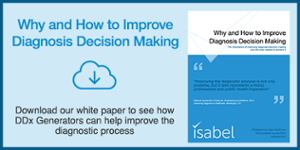- Privacy Policy
- Terms & Conditions
- Contact us
- ©Isabel Healthcare 2025
How far have we come with improving diagnosis? | Isabel Healthcare
 It is nearly two years since the Insitute of Medicine (IOM) released their landmark study and report on "Improving Diagnosis in Healthcare" warning us all that this endeavour was a "moral, professional, and public health imperative.” We blogged about the study at the time, detailing and commenting on the results and report, particularly highlighting the shortcomings when it came to mentioning Health IT and the benefits this could have on improving the diagnostic field.
It is nearly two years since the Insitute of Medicine (IOM) released their landmark study and report on "Improving Diagnosis in Healthcare" warning us all that this endeavour was a "moral, professional, and public health imperative.” We blogged about the study at the time, detailing and commenting on the results and report, particularly highlighting the shortcomings when it came to mentioning Health IT and the benefits this could have on improving the diagnostic field.
This week, the publication Scientific American published a very interesting article on digital health, detailing the ways in which Health IT can and already is helping clinicians make better diagnostic decisions. Indeed, some of the things mentioned in this article written by Dina Fine Maron were in direct correlation with recommendations of the study, and with principles we have been promoting for years, so it is brilliant that this issue gets light in any form, be that a study, and article, or a conversation in a bar.
It starts with education
The IOM report of 2015 shied away from healthcare IT and its benefits, but did suggest that the best place to start improving diagnosis was to focus on the diagnostic skills being taught in education. We believe the best way to do this is to give a young and thriving generation of medical students the tools they require and prefer in order to help them with their studies and indeed careers. Maron's article from this week states that "a growing number of medical schools, teaching hospitals and other care centers are also paying for computer-based assistance such as DXplain or its competitors VisualDx and Isabel" and this is encouraging. Talking about the ways in which these tools are helping students with their medical education will help show how they can in turn help in the qualified medical world to diagnose better. Furthermore, it is these students who will become residents and eventually physicians and specialists in our institutions, and our hope is the diagnostic process as a whole will improve with the improvement of our education in the medical sector.
Human Error and the AI solution
Maron speaks of the human error element to any diagnostic process, and it is one that we have documented well in various articles including our whitepaper on "Why and How to Improve Diagnosis Decision Making." Cognitive bias such as premature closure or anchoring error as mentioned in Maron's article, involves the physician's mind latching onto the first or most obvious diagnosis without considering other options that may be less apparent, therefore potentially leading to a misdiagnosis with possibly drastic outcomes. A strong differential is the only way to be sure of stopping this human error, and tools like Isabel are built specifically to overcome this and suggest the 'what ifs' and red flag diagnoses that could easily be missed. When initially commenting on the IOM report of 2015, we said that the report should have pushed for comprehensive measurements of physicians undertaking differentials with their cases, as this is one great way to ensure the differentials are taking place, and therefore limiting the likelihood of a human cognitive bias. As mentioned in Maron's article, more and more studies are taking place to measure how effective diagnostic tools are at stopping these human errors, and the results are encouraging. A study of our own system showed that medical students could improve their diagnostic capablities by as much as a third by using Isabel.
Answers to some of the questions
Maron's article commented on some hurdles that are yet to be overcome in order for the world to fully embrace the digital health movement within the healthcare environment. We have come a long way with computers now being fully integrated into everyday life in hospitals worldwide, but there is still some resistance to tools like Isabel being adopted. Maron mentions some doctors are reluctant to try the system in their own insititution until they know it works, and for these people perhaps time is all they need. Some are showing resistance because they feel the systems on offer do not integrate sufficiently with their exisiting protocols. For this, we are already offering several API and integration solutions with Isabel, and are constantly striving to make it as seamless a transition as possible. We have even written an eBook on the adoption of tools like Isabel within your institution.
Occasionally, like Sandra Fryhofer in the article by Maron, we will still get someone voicing concerns that computers will take over the doctors' jobs and eventually the universe, and for this we will always reply with the following; doctors cannot and should not be replaced, and diagnostic tools can be used effectively without the knowledge of a doctor. They are designed from the very beginning to co-exist and enhance a doctor's capabilities, never replace.
Finally, there is still a concern of medical institutions not understanding the magnitude of the issue when it comes to improving diagnosis. As with a lot of things in the medical world, we are slowly, very slowly, taking steps in the right direction, and it is articles like this one and the one written by Maron which will help change the medical industry's opinion of both digital health and the importance of improving diagnosis.

Jason Maude
Jason is the CEO and Co-founder of Isabel. Prior to co-founding Isabel, Jason spent 12 years working in finance and investment banking across Europe. His daughter, Isabel, fell seriously ill following a misdiagnosis in 1999 and this experience inspired Jason to abandon his city career and create Isabel Healthcare Ltd.
Subscribe Here!
Recent Posts
Isabel DDx Companion with ChatGPT Integration - to help you diagnose even faster
At Isabel Healthcare, we’ve always been driven by one goal: to make clinical reasoning faster,..Virtual Triage: Do more questions lead to better patient outcomes?
One of the common misconceptions related to virtual triage / symptom checker tools is that the more..List Of Categories
- Differential Diagnosis Decision Support
- Differential diagnosis
- Symptom Checker
- Symptoms
- Medical Error
- Patient Disease Information
- Disease
- Clinical Decision Support
- Diagnostic Decision Support
- Isabel 1 Minute Read
- Diagnosis Error
- Diagnosis Skills Cases
- Healthcare Informatics
- Clinical Reasoning
- Evidence-based Medicine
- Medical Education
- Patient Engagement
- Symptom Triage
- Nurse Practitioner Education
- Nursing Decision Support
- Partnership
- Public Health
- COVID-19
- EHR
- Patient Empowerment
- Patient Safety
- rare disease

Start your FREE Trial today
Try the Isabel Pro DDx generator for 30-days - no payment card details required.




